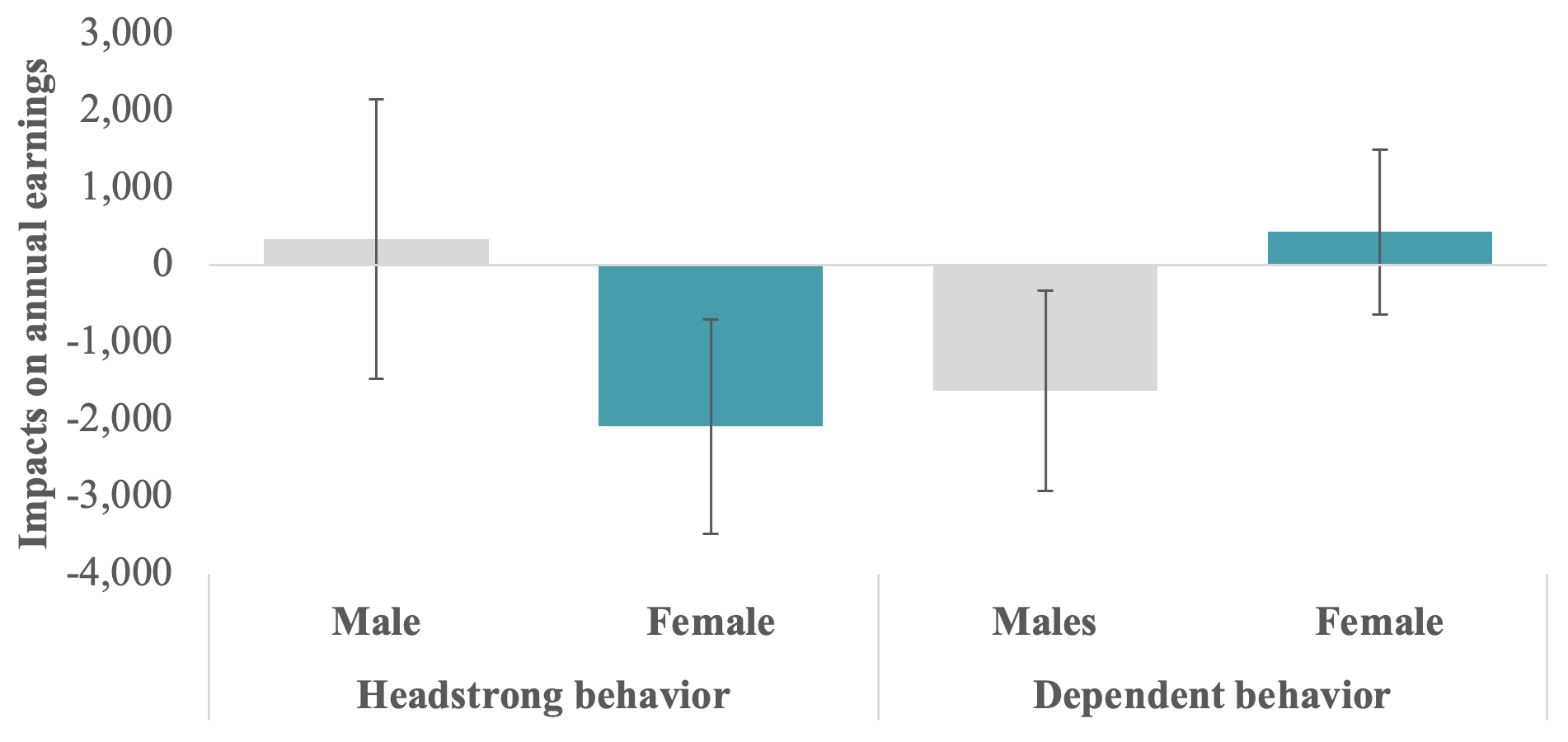Despite substantial convergence in pay and employment levels, gender differences in the labour market persist (Azmat and Petrongolo 2014). Among potential explanations for these disparities are gender differences in preferences (Booth et al. 2012) and labour market discrimination (Booth and Leigh 2010). In recent work (Kaestner and Malamud 2021), we explore the role of gender differences in the labour market returns to various dimensions of child behaviour.
A substantial literature has documented the significant relationship between cognitive skills, measured in childhood and adolescence, and adult earnings (e.g. Murnane et al. 1995). More recently, studies have also shown significant associations between adult earnings and childhood ‘non-cognitive skills’, such as socio-emotional behaviours and temperament (e.g. Heckman et al. 2006, Papageorge et al. 2019). However, there has been relatively little research on gender differences in the labour market returns to childhood ‘non-cognitive skills’, especially when disaggregated into specific domains of behaviour.
We use data from the Children of the National Longitudinal Survey of Youth 1979 (C-NLSY79) to examine associations between several distinct child behavioural problems measured at ages 4 to 12 and adult earnings measured at ages 24 to 30. Our measures of child behavioural problems are drawn from an abbreviated version of the Child Behavior Checklist (CBCL), reported by parents and “designed to measure some of the more common syndromes of problem behavior found in children” (Zill 1985). The CBCL is one of the most widely used assessments of children’s emotional and behavioural problems and has been shown to have strong predictive validity. Like the CBCL on which they are based, the measures of behavioural problems in the C-NLSY79 have also been shown to have strong predictive validity (Parcel and Menaghan 1988).
The specific behavioural syndromes recorded in the C-NLSY79 are:
- antisocial behaviour
- anxiety/depressed mood
- headstrong behaviour
- hyperactive behaviour
- dependent behaviour
- peer conflict.
Items that constitute the behavioural scales are intuitive. For example, children score high on the headstrong scale when their caregiver reports that he or she argues too much; has a strong temper and loses it easily; is disobedient at home; is stubborn, sullen, or irritable; and is rather high strung, tense, and nervous. On the other hand, children can score high on the dependent scale when their mother reports that he or she demands a lot of attention; clings to adults; cries too much; and is too dependent on others. We average the scale scores across all surveys for which the child is present between ages 4 and 12 in order to improve reliability.
Main findings
We find large and significant earnings penalties for women who exhibited more headstrong behaviour and for men who exhibited more dependent behaviour as children. There are no significant or economically meaningful penalties for men who were headstrong or for women who were dependent. While other child behavioural problems are also associated with earnings, their associations do not differ significantly by gender. Below is a graphical representation of the earnings differences associated with headstrong and dependent behaviour by gender (for the full set of estimates across all child behaviours, see Table 2 in Kaestner and Malamud 2021).
Figure 1
These results are robust to alternative specifications of earnings (e.g. levels or logs) and child behaviours (e.g. linear or categorical). The results are also similar with and without adjustment for differences in academic achievement or family background, and when allowing for the effect of family background to differ by gender. While we are careful to avoid making strong causal claims about the estimated relationships, these analyses address some of the more important and potentially confounding influences of family background.
The differential returns to dependent and headstrong behaviour by gender are not mediated by significant gender differences in the associations between child behaviours and the likelihood of employment, work hours, marriage, fertility, or self-esteem. Nor do we find gender differences in the associations between child behaviours and adult personality traits, mental health (CESD), or the probability of being in good health. While we do find that men who were characterised as dependent are significantly more likely to report being in poor health – and this association differs significantly from the corresponding figure for women – these differentials are too small for health to be a significant mediator of the gender difference in the association between dependent behaviour and earnings.
However, we do find heterogeneous gender differences in the returns to headstrong and dependent behaviour by education and occupation. This heterogeneity is suggestive of the role of workplace settings, and perhaps workplace prejudice, in explaining gender differences between these child behaviours and early adult earnings.
Discussion
One potential explanation for our findings is that children who exhibit behaviours that deviate from gender norms and stereotypes may be penalised in the labour market. In our setting, dependent behaviour is more prevalent among girls than boys while headstrong behaviour (along with other child behaviours) is more prevalent among boys than girls. At the same time, numerous public opinion surveys suggest that certain traits, such as stubbornness and decisiveness, are more associated with males while other behaviours, such as sensitivity and being emotional, are more associated with females (Eagly et al. 2019). This hypothesis is consistent with the role congruity theory of prejudice, which posits that men and women who behave in ways that are contrary to expected behaviours are often subject to prejudice (Eagly and Karau 2002). Indeed, men and women who do not conform to gender norms and stereotypes in the labour market have been shown to suffer social and economic sanctions (Akerlof and Kranton 2000, Brescoll and Uhlmann 2008).
Nevertheless, more research is needed to distinguish this hypothesis from alternative explanations. For example, do the moderating effects of gender arise because of differences in actual productivity, or because colleagues and supervisors have negative perceptions of headstrong women and dependent men? The former could arise if behaviour is more pronounced by gender while the latter is consistent with a bias due to non-conforming gender behaviours. Another important question is why other childhood behaviours – such as hyperactive, anti-social, and peer conflict – do not differ in their associations with earnings by gender. Like headstrong behaviour, these behaviours have strong correlations with adult earnings and are more prevalent among boys than girls. So why is the moderating role of gender absent in the case of these behaviours? Perhaps these behaviours are less associated with adult gender stereotypes and therefore not perceived as gender non-conforming behaviours. Or perhaps these behaviours do not lead to negative perceptions on the job because they do not affect social interactions. Further research is needed to answer these questions as well.
References
Akerlof, G and R Kranton (2000), “Economics and Identity”, The Quarterly Journal of Economics 115(3): 715–753.
Azmat, G and B Petrongolo (2014), “Gender and the labour market: Evidence from experiments”, VoxEU.org, 07 June.
Booth, A and A Leigh (2010), “Do employers discriminate by gender in female-dominated occupations? Results from a field experiment”, VoxEU.org, 02 February.
Booth, A, P Nolen and L Cardona Sosa (2012), “Shaping risk preferences across time”, VoxEU.org, 20 February.
Brescoll, V and E Uhlmann (2008), “Can an angry woman get ahead? Status conferral, gender, and expression of emotion in the workplace”, Psychological Science 19(3): 268–275.
Eagly, A and S Karau (2002), “Role congruity theory of prejudice toward female leaders”, Psychological Review 109(3): 573–598.
Eagly, A, C Nater, D Miller, M Kaufmann and S Sczesny (2019), “Gender stereotypes have changed: A cross-temporal meta-analysis of U.S. public opinion polls from 1946 to 2018”, American Psychologist 75(3): 301–315.
Heckman, J, J Stixrud and S Urzua (2006), “The effects of cognitive and non-cognitive abilities on labor market outcomes and social behavior”, Journal of Labor Economics 24(3): 411–482.
Kaestner R and O Malamud (2021), “Headstrong Girls and Dependent Boys: Gender Differences in the Labor Market Returns to Child Behavior”, NBER working paper 29509.
Murnane, R, J Willett and F Levy (1995), “The growing importance of cognitive skills in wage determination”, The Review of Economics and Statistics 77(2): 251–266.
Papageorge, N W, V Ronda and Y Zheng (2019), “The economic value of breaking bad: How childhood misbehaviour can signal something good”, VoxEU.org, 04 May.
Parcel, T and E Menaghan (1988), “Measuring Behavioral Problems in a Large Cross-Sectional Survey: Reliability and Validity for Children of the NLS Youth”, Columbus: The Ohio State University, Department of Sociology.




